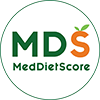More evidence that healthier isn’t more expensive
People still believe that eating healthier costs more than eating the processed foods available in the supermarket or even buying fast food. The problem, however, is how "cost" and "healthier" is defined: is it cost per calorie? Cost per some unit of energy density? What about macro- and micro-nutrients such as carbohydrates, protein, vitamins, and minerals? Depending on the definitions, research is mixed as to whether it's more expensive to eat healthy. We have found that per serving, making your own home made version of processed foods like Hamburger Helper© is both cheaper and you get more to eat by volume, and the same is true of McDonald's.
Yet the myth persists, and in an effort to combat this myth, a team of researchers from the NIH (National Institutes of Health) and the Eunice Kennedy Shriver National Institute of Child Health and Human Development designed a study to evaluate whether families could eat healthier without spending more money (J Acad Dutr Diet 2016;116:1751-1759), choosing to define "healthier" as having higher adherence to the Healthy Eating Index 2005 (HEI-2005), which measures how well an individual's overall diet matches the recommendations in the 2005 Dietary Guidelines for Americans. This is measured on a scale of 1-100, with 100 being perfect adherence.
The authors recruited 136 adolescent men and women with Type 1 Diabetes between the ages of 8 and 16 (and their families) to participate in the 18-month-long study. At the start of the study, half of the families received multiple counseling sessions designed to help them improve their overall diets, focusing on improving their intake of whole plant foods (including whole fruits, vegetables, whole grains, legumes, nuts, and seeds). The other half of the families served as controls and did not receive the counseling. Over the following 18 months all of the adolescent participants completed detailed 3-day diet records every three months for the first year, and then at the end of the study. One of each of the adolescents' parents completed 3-day diet records every 6 months.
At the end of the study the authors assessed the participants' diets and assigned them each a score on the Healthy Eating Index scale as well as a score measuring the amount of whole plant foods the participants consumed.
Using information from applicable restaurants (when the participants reported eating out) as well as pricing from online national grocery stores with brick-and-mortar locations in the region, the authors were able to total the estimated costs of all foods the participants consumed and then estimate the daily diet cost by averaging the cost of food over the number of days in the study.
After taking such variables as age, income, education, and race/ethnicity into account, the authors found that those who received the dietary counseling improved their HEI-2005 scores by an average of 7 points, while the average daily cost of their diet did not change in any statistically significant way.
What this means for you
We like this study because it deals in the real-world issues of buying food - after all, people don't go to the grocery store to buy calories or carbohydrates or monounsaturated fats - they buy food. Similarly, evaluating the participants' diet as a whole makes far more sense than evaluating caloric density or specific micro- or macronutrients. Making small changes in your diet, like switching to whole grain pasta from white pasta, or eating a handful of nuts instead of something from the vending machine, are real-world changes you can make to your diet that overall won't cost you any more, but will improve your overall diet and your health.
First posted: January 4, 2017




